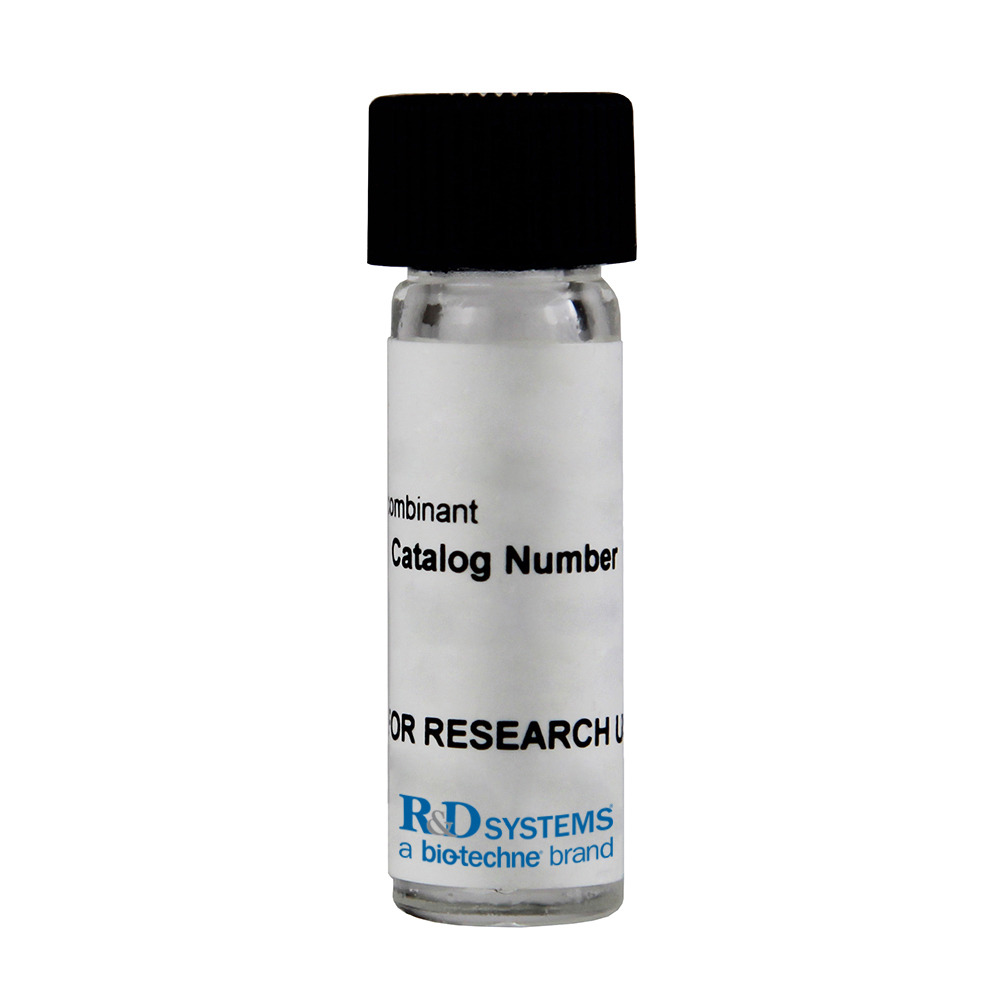Recombinant Mouse IL-11 R alpha (aa 26-367) Fc Chimera, CF
R&D Systems, part of Bio-Techne | Catalog # 7405-MR

Key Product Details
Source
Accession #
Structure / Form
Conjugate
Applications
Product Specifications
Source
| Mouse IL-11 R alpha (Met-Gln367) Accession # NP_001156873 |
DIEGRDP | Mouse IgG2A (Glu98-Lys330) |
| N-terminus | C-terminus |
Purity
Endotoxin Level
N-terminal Sequence Analysis
Predicted Molecular Mass
SDS-PAGE
Activity
The ED50 for this effect is 0.5-2 µg/mL in the presence of 0.75 ng/mL Recombinant Mouse IL‑11 (Catalog # 418-ML)
Reviewed Applications
Read 1 review rated 4 using 7405-MR in the following applications:
Formulation, Preparation and Storage
7405-MR
| Formulation | Lyophilized from a 0.2 μm filtered solution in PBS. |
| Reconstitution |
Reconstitute at 100 μg/mL in PBS.
|
| Shipping | The product is shipped with polar packs. Upon receipt, store it immediately at the temperature recommended below. |
| Stability & Storage | Use a manual defrost freezer and avoid repeated freeze-thaw cycles.
|
Background: IL-11 R alpha
Interleukin‑11 receptor alpha (IL‑11 R alpha, IL‑11 R alpha1) originally designated NR1 in mouse, is a 49 kDa type I transmembrane protein that is a member of the gp130 subfamily of the hematopoietic cytokine receptor family (1‑4). Mouse IL‑11 R alpha cDNA encodes 432 amino acids (aa) including a 23 aa signal peptide, a 349 aa extracellular domain (ECD) that contains a C2 type Ig‑like domain, two fibronectin type III domains, two potential glycosylation sites and a WSXWS motif, a 21 aa transmembrane region and a short (39 aa) cytoplasmic domain (4). Mouse IL‑11 R alpha shares 84%, 95%, 85% and 82% aa sequence identity with human, rat, equine and bovine IL‑11 R alpha, respectively. In mouse, a second IL‑11 R (called alpha2 or beta) that differs by only 4 aa is expressed primarily in the testes (5). IL-11 R alpha first binds IL‑11 with low affinity, then forms a high affinity receptor when complexed with gp130 homodimers (1, 3). IL‑11 R alpha is widely expressed in adults, embryos and embryonic stem cells (4‑6). Deletion in female mice causes faulty decidualization and lack of decidual NK cells and results in infertility (7‑9). IL-11 is anti-apoptotic for oligodendrocytes, and lack of IL‑11 R alpha increases the severity of experimental autoimmune encephalitis (10, 11). IL‑11 R alpha is also anti-apoptotic for colonic epithelia, and increased IL‑11 signaling may be a factor in inflammation-associated gastrointestinal cancer development (3, 12). IL‑11 R alpha enhances osteoclast differentiation and bone remodeling, but inhibits adipocyte differentiation (1, 2). Recombinant soluble IL‑11 R alpha confers IL‑11 responsiveness to cells expressing gp130, while in cells expressing transmembrane IL‑11 R alpha and gp130, soluble IL‑11 R alpha acts as an IL‑11 antagonist (13‑15).
References
- Sims, N.A. and N.C. Walsh (2010) BMB Reports 43:513.
- White, U.A. and J.M. Stephens (2011) Curr. Pharm. Des. 17:340.
- Kiessling, S. et al. (2004) J. Biol. Chem. 279:10304.
- Hilton, D.J. et al. (1994) EMBO J. 13:4765.
- Bilinski, P. et al. (1996) Biochem. J. 320:359.
- Davidson, A.J. et al. (1997) Stem Cells 15:119.
- Paiva, P. et al. (2009) Cytokine Growth Factor Rev. 20:319.
- Robb, L. et al. (1998) Nat. Med. 4:303.
- Ain, R. et al. (2004) Dev. Dyn. 231:700.
- Gurfein, B.T. et al. (2009) J. Immunol. 183:4229.
- Zhang, J. et al. (2011) J. Immunol. 187:1129.
- Putoczki, T. and M. Ernst (2010) J. Leukoc. Biol. 88:1109.
- Curtis, D.J. et al. (1997) Blood 90:4403.
- Baumann, H. et al. (1996) J. Immunol. 157:284.
- Karow, J. et al. (1996) Biochem. J. 318:489.
Long Name
Alternate Names
Gene Symbol
UniProt
Additional IL-11 R alpha Products
Product Documents for Recombinant Mouse IL-11 R alpha (aa 26-367) Fc Chimera, CF
Product Specific Notices for Recombinant Mouse IL-11 R alpha (aa 26-367) Fc Chimera, CF
For research use only
